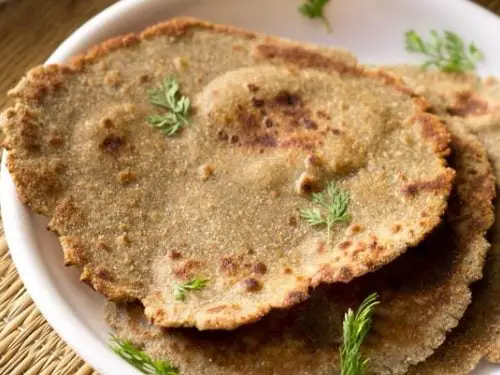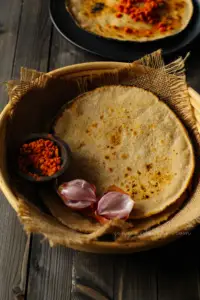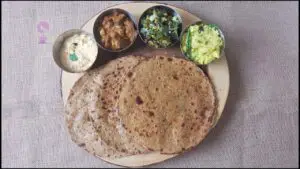Bhakri is a traditional flatbread from Maharashtra, a state in western India. It is made from gluten-free flour called jowar (sorghum flour) or bajra (pearl millet flour). It is typically round and thick, and it is a staple in Maharashtrian cuisine.
Bajre ki roti is indeed a delicious and nutritious way to incorporate millet into your diet. It offers several health benefits and is a popular choice for those looking to improve their gut health, manage weight, and stabilize blood sugar levels.
Bhakri is known for its nutritional benefits. It is high in dietary fiber, provides energy, and contains essential minerals. Depending on the type of flour used, it can be gluten-free, making it suitable for individuals with gluten intolerance or celiac disease.
In addition to its taste and nutritional value, bhakri holds cultural significance as it is a traditional food of the region. It is often prepared during festivals, special occasions, or as a part of everyday meals.
Bajre ki roti is a delicious and wholesome bread that adds a traditional touch to Indian cuisine. It offers a unique texture and flavor profile, making it a popular choice for those seeking a different experience from regular flatbreads.
Ingredients:
- 2 cups coarse whole wheat flour or bajra (pearl millet) flour
- Warm water for kneading
- Salt to taste
- Ghee or oil for cooking
Instructions:
- In a mixing bowl, combine the flour and salt. Gradually add warm water while kneading the dough until it comes together and forms a smooth, firm ball. The amount of water required may vary, so add it gradually to achieve the right consistency.
- Once the dough is formed, cover it and let it rest for about 15-20 minutes. This will make it easier to roll out.
- After resting, divide the dough into small portions and shape them into balls.
- Take one portion of the dough and flatten it slightly with your hands.
- Dust the working surface and the dough ball with some flour to prevent sticking. Roll out the dough ball into a circular disc, about 6-8 inches in diameter. It is typically thicker than regular rotis or chapatis.
- Heat a tawa or griddle over medium heat. Once hot, place the rolled bhakri onto the tawa.
- Cook for about a minute or until you start seeing small bubbles forming on the surface.
- Flip and cook the other side for another minute.
- Apply a little ghee or oil on both sides of the bhakri and cook for a few more seconds until it turns golden brown and is cooked through.
- Remove the cooked bhakri from the tawa and place it in a warm container or cover it with a clean cloth to keep it soft.
- Repeat the process with the remaining dough portions to make more bhakris.
- Serve it hot with your favorite curry, pickle, or yogurt.
- Enjoy your homemade bhakri!
Tips:
- Use warm water for kneading the dough. This helps in better absorption of water and results in a softer bhakri.
- Knead the dough well.
- While rolling out, use gentle pressure to maintain its thickness. Thicker bhakris are traditional, but you can adjust the thickness according to your preference.
- Cooking time may vary based on the thickness. Keep an eye on it while cooking to avoid burning.
- Apply ghee or oil on both sides while cooking to make it more flavorful and prevent it from drying out.
- Store them in a warm container or wrap them in a cloth to keep them soft.
Variations:
- Multigrain: Combine different flours like wheat, jowar (sorghum), bajra (pearl millet), and ragi (finger millet) to make a wholesome multigrain bhakri. Adjust the proportions as per your preference.
- Methi: Add chopped fenugreek leaves (methi) to the dough while kneading. This adds a unique flavor and aroma to the bhakri.
- Spiced: Mix in spices like red chili powder, turmeric powder, cumin powder, or ajwain (carom seeds) to the dough for a spicier version of bhakri.
- Sesame: Sprinkle some sesame seeds on top of the rolled-out bhakri before cooking. It adds a nice crunch and flavor.
- Garlic: Crush or finely chop garlic cloves and mix them into the dough for a garlicky twist to the bhakri.
- Stuffed: Make a filling of your choice, such as spiced mashed potatoes, paneer (cottage cheese), or mixed vegetables. Roll out two smaller discs, place the filling in between, and seal the edges. Roll it out again gently and cook the stuffed bhakri.
Serving suggestions
Bhakri pairs well with a wide range of Indian curries and sabzis. You can serve it with traditional Maharashtrian dishes like Bharli Vangi (stuffed eggplant), Batata Rassa (spicy potato curry), or Amti (spiced lentil curry). It also goes well with Punjabi-style curries like Palak Paneer (spinach and cottage cheese curry), Chole (chickpea curry), or Rajma (kidney bean curry).
Bhakri tastes delicious when accompanied by a tangy pickle or chutney. You can serve it with mango pickle, lemon pickle, garlic chutney, or coriander chutney. These add a burst of flavor to the meal.
It can be enjoyed with plain yogurt or raita (yogurt-based condiment). A simple cucumber raita or onion-tomato raita complements the flavors of the bhakri and provides a cooling element to the meal.
The dish tastes delicious when dipped in lentil soups like Dal Tadka or Moong Dal Soup. It makes for a comforting and wholesome meal.
FAQs
- Q: Can I use regular wheat flour instead of coarse whole wheat flour?
A: While traditionally bhakri is made with coarse whole wheat flour, you can use regular wheat flour as a substitute. However, keep in mind that the texture and taste may differ slightly.
- Q: Is bhakri gluten-free?
A: Bhakri made with pearl millet flour (bajra) is gluten-free. However, if you’re using whole wheat flour, it contains gluten. So, if you have gluten intolerance or celiac disease, opt for bajra flour to make gluten-free bhakris.
- Q: How thick should Bhakris be?
A: it are typically thicker than regular rotis or chapatis. Aim for a thickness of around 1/4 to 1/2 inch (0.6 to 1.3 cm). However, you can adjust the thickness according to your preference.
- Q: How do I store leftover bhakris?
A: If you have leftover bhakris, allow them to cool completely and store them in an airtight container or ziplock bag. They can be stored at room temperature for 1-2 days. To keep them soft, reheat them on a tawa or griddle before serving.
- Q: Can I make bhakris without oil or ghee?
A: While adding oil or ghee enhances the flavor and texture, you can make them without it if desired. However, keep in mind that they may turn out slightly drier.
- Q: Can I make bhakris without a tawa or griddle?
A: A tawa or griddle is ideal, but if you don’t have one, you can use a non-stick pan or skillet instead.
Nutrition
| Calories | 400-500kcal |
| Fat | 20-25g |
| Sodium |
600-800mg
|
| Suger |
5-10g
|
| Carbohydrates | 20-25g |
| Protein | 30-35g |
| Fiber |
2-3g
|
Also, read:
- Kadai chicken recipe (Restaurant Style)
- Fish Kabab Recipe
- Chicken lollipop recipe (Drums Of Heaven)
- Chicken Do Pyaza (Murgh do Pyaza)
- Tangdi Kabab Recipe
follow us on instagram, facebook and youtube



